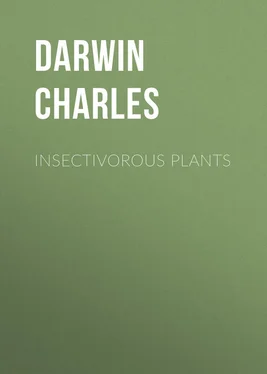Charles Darwin - Insectivorous Plants
Здесь есть возможность читать онлайн «Charles Darwin - Insectivorous Plants» — ознакомительный отрывок электронной книги совершенно бесплатно, а после прочтения отрывка купить полную версию. В некоторых случаях можно слушать аудио, скачать через торрент в формате fb2 и присутствует краткое содержание. Жанр: foreign_antique, foreign_prose, на английском языке. Описание произведения, (предисловие) а так же отзывы посетителей доступны на портале библиотеки ЛибКат.
- Название:Insectivorous Plants
- Автор:
- Жанр:
- Год:неизвестен
- ISBN:нет данных
- Рейтинг книги:5 / 5. Голосов: 1
-
Избранное:Добавить в избранное
- Отзывы:
-
Ваша оценка:
- 100
- 1
- 2
- 3
- 4
- 5
Insectivorous Plants: краткое содержание, описание и аннотация
Предлагаем к чтению аннотацию, описание, краткое содержание или предисловие (зависит от того, что написал сам автор книги «Insectivorous Plants»). Если вы не нашли необходимую информацию о книге — напишите в комментариях, мы постараемся отыскать её.
Insectivorous Plants — читать онлайн ознакомительный отрывок
Ниже представлен текст книги, разбитый по страницам. Система сохранения места последней прочитанной страницы, позволяет с удобством читать онлайн бесплатно книгу «Insectivorous Plants», без необходимости каждый раз заново искать на чём Вы остановились. Поставьте закладку, и сможете в любой момент перейти на страницу, на которой закончили чтение.
Интервал:
Закладка:
The Inflection of the Exterior Tentacles, when their Glands are excited by Repeated Touches.
We have already seen that, if the central glands are excited by being gently brushed, they transmit a motor impulse to the exterior tentacles, causing them to bend; and we have now to consider the effects which follow from the glands of the exterior tentacles being themselves touched. On several occasions, a large number of glands were touched only once with a needle or fine brush, hard enough to bend the whole flexible tentacle; and though this must have caused a thousand-fold greater pressure than the weight of the above described particles, not a tentacle moved. On another occasion forty-five glands on eleven leaves were touched once, twice, or even thrice, with a needle or stiff bristle. This was done as quickly as possible, but with force sufficient to bend the tentacles; yet only six of them became inflected, – three plainly, and three in a slight degree. In order to ascertain whether these tentacles which were not affected were in an efficient state, bits of meat were placed on ten of them, and they all soon became greatly incurved. On the other hand, when a large number of glands were struck four, five, or six times with the same force as before, a needle or sharp splinter of glass being used, a much larger proportion of tentacles became inflected; but the result was so uncertain as to seem capricious. For instance, I struck in the above manner three glands, which happened to be extremely sensitive, and all three were inflected almost as quickly, as if bits of meat had been placed on them. On another occasion I gave a single for- cible touch to a considerable number of glands, and not one moved; but these same glands, after an interval of some hours, being touched four or five times with a needle, several of the tentacles soon became inflected.
The fact of a single touch or even of two or three touches not causing inflection must be of some service to the plant; as during stormy weather, the glands cannot fail to be occasionally touched by the tall blades of grass, or by other plants growing near; and it would be a great evil if the tentacles were thus brought into action, for the act of re-expansion takes a considerable time, and until the tentacles are re-expanded they cannot catch prey. On the other hand, extreme sensitiveness to slight pressure is of the highest service to the plant; for, as we have seen, if the delicate feet of a minute struggling insect press ever so lightly on the surfaces of two or three glands, the tentacles bearing these glands soon curl inwards and carry the insect with them to the centre, causing, after a time, all the circumferential tentacles to embrace it. Nevertheless, the movements of the plant are not perfectly adapted to its requirements; for if a bit of dry moss, peat, or other rubbish, is blown on to the disc, as often happens, the tentacles clasp it in a useless manner. They soon, however, discover their mistake and release such innutritious objects.
It is also a remarkable fact, that drops of water falling from a height, whether under the form of natural or artificial rain, do not cause the tentacles to move; yet the drops must strike the glands with considerable force, more especially after the secretion has been all washed away by heavy rain; and this often occurs, though the secretion is so viscid that it can be removed with difficulty merely by waving the leaves in water. If the falling drops of water are small, they adhere to the secretion, the weight of which must be increased in a much greater degree, as before remarked, than by the addition of minute particles of solid matter; yet the drops never cause the tentacles to become inflected. It would obviously have been a great evil to the plant (as in the case of occasional touches) if the tentacles were excited to bend by every shower of rain; but this evil has been avoided by the glands either having become through habit insensible to the blows and prolonged pressure of drops of water, or to their having been originally rendered sensitive solely to the contact of solid bodies. We shall hereafter see that the filaments on the leaves of Dionaea are likewise insensible to the impact of fluids, though exquisitely sensitive to momentary touches from any solid body.
When the pedicel of a tentacle is cut off by a sharp pair of scissors quite close beneath the gland, the tentacle generally becomes inflected. I tried this experiment repeatedly, as I was much surprised at the fact, for all other parts of the pedicels are insensible to any stimulus. These headless tentacles after a time re-expand; but I shall return to this subject. On the other hand, I occasionally succeeded in crushing a gland between a pair of pincers, but this caused no inflection. In this latter case the tentacles seem paralysed, as likewise follows from the action of too strong solutions of certain salts, and by too great heat, whilst weaker solutions of the same salts and a more gentle heat cause movement. We shall also see in future chapters that various other fluids, some vapours, and oxygen (after the plant has been for some time excluded from its action), all induce inflection, and this likewise results from an induced galvanic current. 6 6 My son Francis, guided by the observations of Dr. Burdon Sanderson on Dionaea, finds that if two needles are inserted into the blade of a leaf of Drosera, the tentacles do not move; but that if similar needles in connection with the secondary coil of a Du Bois inductive apparatus are inserted, the tentacles curve inwards in the course of a few minutes. My son hopes soon to publish an account of his observations.
CHAPTER III
Nature of the contents of the cells before aggregation – Various causes which excite aggregation – The process commences within the glands and travels down the tentacles – Description of the aggregated masses and of their spontaneous movements – Currents of protoplasm along the walls of the cells – Action of carbonate of ammonia – The granules in the protoplasm which flows along the walls coalesce with the central masses – Minuteness of the quantity of carbonate of ammonia causing aggregation – Action of other salts of ammonia – Of other substances, organic fluids, &c. – Of water – Of heat – Redissolution of the aggregated masses – Proximate causes of the aggregation of the protoplasm – Summary and concluding remarks – Supplementary observations on aggregation in the roots of plants.
I WILL here interrupt my account of the movements of the leaves, and describe the phenomenon of aggregation, to which subject I have already alluded. If the tentacles of a young, yet fully matured leaf, that has never been excited or become inflected, be examined, the cells forming the pedicels are seen to be filled with homogeneous, purple fluid. The walls are lined by a layer of colourless, circulating protoplasm; but this can be seen with much greater distinctness after the process of aggregation has been partly effected than before. The purple fluid which exudes from a crushed tentacle is somewhat coherent, and does not mingle with the surrounding water; it contains much flocculent or granular matter. But this matter may have been generated by the cells having been crushed; some degree of aggregation having been thus almost instantly caused.
If a tentacle is examined some hours after the gland has been excited by repeated touches, or by an inorganic or organic particle placed on it, or by the absorption of certain fluids, it presents a wholly changed appearance. The cells, instead of being filled with homogeneous purple fluid, now contain variously shaped masses of purple matter, suspended in a colourless or almost colourless fluid. The change is so conspicuous that it is visible through a weak lens, and even sometimes by the naked eye; the tentacles now have a mottled appearance, so that one thus affected can be picked out with ease from all the others. The same result follows if the glands on the disc are irritated in any manner, so that the exterior tentacles become inflected; for their contents will then be found in an aggregated condition, although their glands have not as yet touched any object. But aggregation may occur independently of inflection, as we shall presently see. By whatever cause the process may have been excited, it commences within the glands, and then travels down the tentacles. It can be observed much more distinctly in the upper cells of the pedicels than within the glands, as these are somewhat opaque. Shortly after the tentacles have re-expanded, the little masses of protoplasm are all redissolved, and the purple fluid within the cells becomes as homogeneous and transparent as it was at first. The process of redissolution travels upwards from the bases of the tentacles to the glands, and therefore in a reversed direction to that of aggregation. Tentacles in an aggregated condition were shown to Prof. Huxley, Dr. Hooker, and Dr. Burdon Sanderson, who observed the changes under the microscope, and were much struck with the whole phenomenon.
Читать дальшеИнтервал:
Закладка:
Похожие книги на «Insectivorous Plants»
Представляем Вашему вниманию похожие книги на «Insectivorous Plants» списком для выбора. Мы отобрали схожую по названию и смыслу литературу в надежде предоставить читателям больше вариантов отыскать новые, интересные, ещё непрочитанные произведения.
Обсуждение, отзывы о книге «Insectivorous Plants» и просто собственные мнения читателей. Оставьте ваши комментарии, напишите, что Вы думаете о произведении, его смысле или главных героях. Укажите что конкретно понравилось, а что нет, и почему Вы так считаете.












